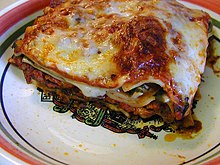Cookbook:Lasagne
Cookbook | Recipes | Ingredients | Equipment | Techniques | Cookbook Disambiguation Pages | Cuisine of Italy | Pasta Recipes

Lasagna is a popular oven-baked pasta dish made of fresh egg pasta squares. It is a traditional dish from Bologna in Northern Italy, where the sheets are always green through the addition of spinach or nettles to the egg dough. In Bologna, these home made sheets are layered with small amounts of real Bolognese ragù (made with both beef and pork, very little tomato, and no southern herbs like oregano and basil but a little nutmeg instead) and similarly small amounts of "besciamella" or béchamel sauce in an oven dish. There are at least 5 layers of pasta dough, and the layers stay separate and do not "merge" together into a mush. A light sprinkling of Parmigiano-Reggiano, and a few dabs of butter end the dish, which is then baked for about half an hour. The use of Mozzarella in place of Béchamel suggests a Neapolitan variation on the original Bologna classic, as does the use of Ricotta.
Lasagne refers to multiple sheets of pasta; lasagna refers to the dish or to individual sheets of pasta.
In Italy, but especially outside, many lasagna variations exist today. Vegetable lasagna, lasagna without béchamel sauce, lasagna without any sauce (just vegetables and/or meat), or even lasagna without sheets of pasta.
When assembling a lasagna, start with the main ingredient (ragu, vegetables, seafood, etc.), add a layer of béchamel sauce, then one layer of lasagne pasta sheets, and then the main ingredient again. Continue until the oven dish is full. End with a layer of pasta, spread some béchamel sauce on top, and sprinkle the cheese over it.
The Pasta
[edit | edit source]When it comes to the pasta dough there is, as always, a choice between home-made pasta and store bought sheets of dried pasta. Since dried pasta is made with just water and flour and home made fresh pasta usually includes eggs, there is a distinct difference in flavour and texture. The main difference, however, comes from ease of use. Making pasta from scratch can be a lengthy process and takes some practice to get it right. See the pasta page for a fresh pasta recipe.
Dried pasta is usually precooked, so it can be put in to the oven dish straight out of the packet.
In the US, pasta sheets generally have a curvy surface. Outside the US, they are almost always flat.
Apart from the plain lasagne sheets, the green ones that Bologna favours are also common. These are called lasagne verdi and are flavored with spinach. They work well with white sauces (bechamels or cream-based sauces and seafood.
General Guidelines for making Lasagna
[edit | edit source]- Most packaged lasagna need to cook in a preheated oven for 30 to 50 minutes (based on the size) at gas mark 4 (350°F/180°C).
Notes, Tips & Variations
[edit | edit source]- Some recipes call for the béchamel sauce to be mixed through the ragu or tomato sauce, while others tell you to layer it between the pasta and the ragu. This seems to be based on personal preference and taste.
- Besides sprinkling cheese on top of the lasagna, it's also a good idea to mix some through the béchamel sauce, to give the lasagna some cheese flavor throughout, instead of just on top. Turn the heat off under the béchamel sauce before adding the cheese, or the sauce will become rubbery.
- A Moussaka is essentially a lasagna with slices of eggplant instead of pasta.
- A Pastitsio, or Greek Lasagna, is a Greek casserole like lasagna where the ragu is combined with tubular pasta, and topped with a béchamel sauce.
- A Scacchi or mina is a lasagna-like dish made during Passover by some Italian and Sephardic Jews, using broth or water-soaked matzo as the starch layer and generally containing ground beef or lamb, spinach or other greens, and other vegetables as ingredients.
